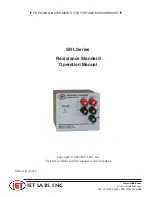
Chapter 4: Troubleshooting
Under-Voltage Fault
61
(LOWER ACQ). If any of the following three indicator LEDs are illuminated (BP POL FAIL, NEG
SUPPLY FAIL, or FPGA SUPPLY FAIL), replace the backplane assembly.
If the FP SUPPLY FAIL LED is on by itself, there may be a problem with one of the supplies
that goes to the front panel assembly or there may be a problem on the front panel assembly
itself. Unplug the front panel power-connector (see cable circled in Figure 4-6) and turn the
unit on again. See if any of the other under-voltage indicator LEDs on the backplane assembly
turn on. If not, the fault is on the front panel assembly and it should be replaced. If either the
BP POL FAIL or NEG SUPPLOES FAIL indicator LEDs turn on then replace the backplane
assembly and confirm the fault goes away with the front panel power reconnected to the
backplane assembly.
Figure 4-6
If the unit turns off after two seconds and no under-voltage fault indicator LEDs are illuminated,
the bulk 12V supply may be defective and, therefore, might need to be replaced. First verify that
the +5V standby potential from the bulk supply is good by confirming the green LED on the
motherboard is illuminated. If this LED is not illuminated when AC power is applied to the
instrument, the bulk 12V supply might need to be replaced. Be sure to verify the operation of
the AC OK and DC OK signals first. The AC OK signal indicates that the applied AC signal is
within the specified input range (TTL high logic level indicates AC input is good). It is possible
for this signal to indicate the AC input is not within the requested range even though it is correct.
The DC OK signal indicates whether the main output from the supply (+12.6V) is good (TTL
high logic level indicates the DC output is good). It is possible for this output to be false even
though the supply output is correct. Both of these outputs are open collectors and would require
a pull-up resistor to some external potential to confirm the output logic level is high or a simple
resistance measurement to ground would tell you whether the open collector output transistors
are turned off indicating both outputs would be in the logic high state.
It is also possible that there is a short circuit on the bulk 12V supply net somewhere in the
system which would also result in the unit now powering on. If this happens, you need to isolate
the assembly that is shorted. You can hopefully perform the following diagnostic tasks without
having to remove the acquisition or backplane assemblies.
First, disconnect the bulk 12V supply (see Figure 4-7), but do not remove the supply from the
Summary of Contents for Infiniium 90000 A
Page 4: ...4...
Page 13: ...2 To run the self calibration 15 Calibration...
Page 14: ...14 Calibration This chapter provides self calibration procedures for the oscilloscope...
Page 50: ...Chapter 3 Testing Performance Performance Test Record 50...
Page 58: ...Chapter 4 Troubleshooting Power Supply Trouble Isolation 58 Figure 4 4...
Page 71: ...Chapter 4 Troubleshooting Display Trouble Isolation 71 Display Trouble Isolation...
Page 88: ...Chapter 4 Troubleshooting To check probe power outputs 88...
Page 126: ...Chapter 5 Replacing Assemblies To remove and replace the USB or GPIB port 126...
Page 129: ...Chapter 6 Replaceable Parts Exploded Views 129 Exploded Views Front Frame and Front Panel...
Page 130: ...Chapter 6 Replaceable Parts Exploded Views 130 Fan and Acquisition Assembly...
Page 131: ...Chapter 6 Replaceable Parts Exploded Views 131 Power Supply and PC Motherboard...
Page 132: ...Chapter 6 Replaceable Parts Exploded Views 132 Sleeve and Accessory Pouch...
Page 136: ...Chapter 6 Replaceable Parts Replaceable Parts List 136...
Page 138: ...Chapter 7 Theory of Operation 138 Figure 7 1 Oscilloscope Block Diagram...
Page 146: ...146 Figure 7 6 Acquisition board block diagram...
















































